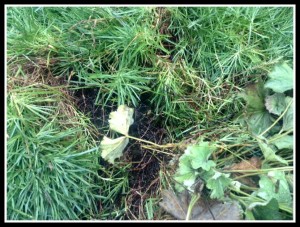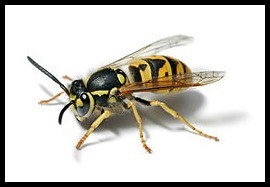
Hard to see, but this hole was swarming with yellow jackets.
A Problem Revealed
While working at my desk a week or so ago, I noticed lots of activity near the sidewalk. Small creatures of some sort were flying up and down and in circles, over and over again. They reminded me of popcorn kernals flying in a popcorn machine.
I went outside to investigate. There, dug in below a Bath’s Cheddar pink dianthus that normally serves as a ground cover, was a hole about six inches in diameter. The flying creatures appeared to be bees of some kind, and they were as busy and active as could be. Unknown to me, they must have been there most of the summer.
Fortunately, they did not seem very interested in me. I stood and watched them for a few minutes while they continued about their mysterious business, which appeared to me simply to be flying out and going back in.
 The creatures were not big. They had yellow and black stripes. They are obviously some kind of bee or bee relative, I thought. After some Google time, reading about ground bees and learning that they are typically solitary, I decided that these clearly social insects were yellow jackets. I was quite surprised to learn that yellow jackets are able to dig holes this size. It turns out that often, they build on abandoned rodent tunnels. Inside the holes, they build the complicated honeycomb nests that we have all seen.
The creatures were not big. They had yellow and black stripes. They are obviously some kind of bee or bee relative, I thought. After some Google time, reading about ground bees and learning that they are typically solitary, I decided that these clearly social insects were yellow jackets. I was quite surprised to learn that yellow jackets are able to dig holes this size. It turns out that often, they build on abandoned rodent tunnels. Inside the holes, they build the complicated honeycomb nests that we have all seen.
The Internet informed me that yellow jackets become more ornery than usual at this time of the year. Why is this? According to the website All About Yellow Jackets, these aggressive insects are carnivores in spring and early summer. They feed mostly on other insects to provide protein to developing larvae in their colony. (While doing this, they help keep garden pests in check.) As the season progresses, their population grows. Their diet changes to include more sugars. This is when they turn to “scavenging, lurking around garbage cans and pestering picnickers.”
The site also recommended several extermination methods, ranging from drowning the insects to spraying poison into the hole. It warned that these insects could swarm if provoked. The whole business was a bit daunting. It was a problem I wished we didn’t have.
A Problem Grows
When I showed the nest to the woman who helps us with the garden, she said, “There are more.” She proceeded to show us three additional holes the same size, all within 15 feet of each other. All four were swarming and active. Could they all be part of the same colony? I still do not know the answer to that question.
My inclination was to leave them be. Why kill something that is going to die in a few weeks anyway? But both my husband and I were worried about our grandchildren, who were coming for a visit the following Sunday. They would pass right by the sidewalk nest as they came into the house, if they followed their normal route. Should we kill the yellow jackets, then, to protect the children?
A Problem Solved
I was coming to the conclusion that we needed to do something. As it turned out, however, Mother Nature took care of our problem for us.
The day before the kids were due to visit, I went outside to marvel at the nest again and decide once and for all what we were going to do. But a surprise awaited me. The nest was quiet. It was empty, except for two or three yellow jackets who seemed a bit disoriented — a far cry from the hundreds or even thousands that were buzzing about before. The plant around the nest was torn back.
We concluded that a predator must have raided the nest. Back to the Internet I went to look up yellow jacket predators. Bears are the most common, said Wikipedia, but … thankfully, we don’t have bears. Next most likely suspects were skunks, raccoons, and badgers. We don’t have badgers, either, at least not as far as I know. But we do have skunks and raccoons around here, tempted by Serendipity Gardens’ abundance. It must have been one of them.
Our dog Nestle had, in fact, barked late in the evening, several times, on the preceding day. We took little notice. In retrospect, however, she must have sensed our predator snacking on those tasty (if you are a skunk or a raccoon) yellow jackets. The temperature had been quite chilly that night, dipping down into the 40’s — most unusual for August. That chill would have made the yellow jackets quite sluggish, and an easy target.
It’s Not Foolproof
I know that having a garden suited for wildlife does not always guarantee that just when I need it, a predator will come and solve a problem. Predators have come here and nabbed prey when I did not want them to at all, such as when a blue heron visited our pond to snatch a few frogs.
Despite this caveat, a family-friendly, chemical-free solution to a problem like yellow jackets is a more likely outcome when your yard and garden are functioning as an ecosystem — which you can work to make happen by providing creatures with food, water, shelter, and places to rear their young.
The Serendipity Gardens crew hopes you go for it!
Read about yellow jackets on Wikipedia. Read about possible extermination methods on All About Yellow Jackets.
Like this post? Sign up to receive an email each time a new post is available. We will never loan, sell or rent your email address — that’s a promise! Please use the buttons below to share with others.
